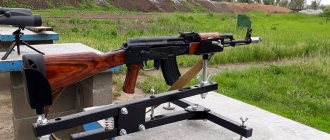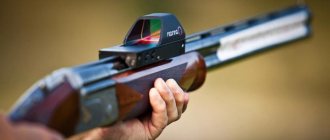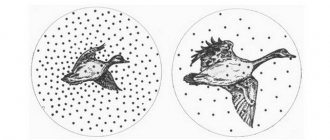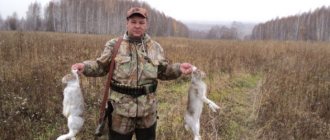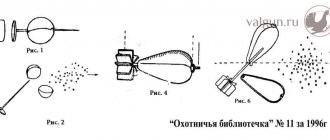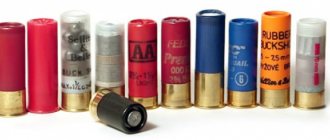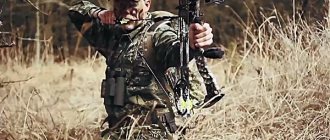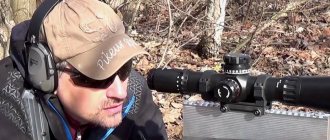General provisions
76. An assault rifle (machine gun) located in a unit must always be brought into normal combat.
Checking the combat of an assault rifle (machine gun) is carried out:
- upon his admission to the unit;
- after repairs, replacement of parts that could change its combat;
- when abnormal deviations of bullets are detected during shooting.
In a combat situation, all opportunities must be used to periodically check the combat of machine guns (machine guns) and bring them to normal combat.
77. Before checking the combat, the machine gun (machine gun) should be carefully inspected and any defects found should be eliminated.
78. Checking the combat of an automatic rifle (machine gun) and bringing it to normal combat is carried out under the direction of the company (battery, platoon) commander at a shooting range in a windless environment, in a closed shooting range or in a section of the shooting range protected from the wind under normal lighting.
Direct superiors (up to and including the unit commander) are required to ensure strict compliance with the rules for checking combat and bringing machine guns (machine guns) to normal combat.
79. Shooting when checking the combat of machine guns (machine guns) and bringing them to normal combat is carried out by the best machine gunners (machine gunners) selected by the unit commander.
When checking the battle, machine gunners (machine gunners) who are assigned machine guns (machine guns), their squad commanders and a weapons repairman with the necessary tools must be present.
80. Checking the combat of an assault rifle (machine gun) and bringing it to normal combat is carried out by firing cartridges with an ordinary bullet. Firing range 100 m, sight 3, rear sight 0. Firing position: from a machine gun - lying down, from a machine gun - lying down from a bipod. Automatic - without a bayonet. The machine gun is brought into normal combat with a muzzle brake-compensator, and the machine gun is equipped with a flash suppressor, which are not screwed together during firing.
81. Shooting is carried out at a test target (or at a black rectangle measuring 35 cm in height and 25 cm in width), mounted on a white shield 1 m high and 0.6 m wide. When shooting at a test target (Fig. 53) with an aiming point serves as the middle of the lower edge of the target, cut off when firing from a machine gun along the fifth horizontal line, when firing from a machine gun - along the eighth horizontal line; The center of the circles is taken as the control point (the normal position of the midpoint of impact). When shooting at a black rectangle, the aiming point is the middle of the lower edge of the rectangle; the position of the control point is marked along a plumb line above the aiming point when firing from a machine gun at a distance of 13 cm, from a machine gun - at a distance of 11 cm. The aiming point should be approximately at eye level of the shooter.
Rice. 53. Test target
82. Checking the combat and bringing it to normal combat is carried out: for an assault rifle - by firing single shots (4 rounds), for a machine gun - first by firing single shots (4 rounds), and then with automatic fire (8 rounds in 2-3 bursts).
Checking the battle
83. To check the combat with single shots, the shooter fires four shots, carefully and uniformly aiming at the middle of the lower edge of the test target (black rectangle). At the end of the shooting, the commander in charge of the battle check examines the target and, based on the location of the holes, determines the accuracy of the battle and the position of the midpoint of impact. Soldiers and sergeants performing shooting are not allowed to inspect the targets.
84. The accuracy of the combat is considered normal if all four holes or three (with one broken off) fit into a circle with a diameter of 15 cm. If the accuracy of the holes does not satisfy this requirement, then the shooting is repeated. If the shooting result is unsatisfactory again, send the machine gun (machine gun) to a repair shop to eliminate the causes of bullet scatter.
If the accuracy of the holes is considered normal, the commander determines the midpoint of the impact and its position relative to the control point.
85. To determine the average point of impact using four holes you need:
- connect the two nearest holes with a straight line and divide the distance between them in half;
- connect the resulting point with the third hole and divide the distance between them into three equal parts;
- connect the division point closest to the first two holes with the fourth hole and divide the distance between them into four equal parts.
The division point closest to the first three holes will be the average point of impact of the four holes (Fig. 54, a).
The midpoint of impact can also be determined in the following way: connect the holes in pairs, then connect the midpoints of both straight lines and divide the resulting line in half; the division point will be the middle point of impact (Fig. 54.6).
Rice. 54. Determination of the average point of impact:
a, b - along four holes; c - along three holes; d - identification of a detached hole; d - when firing with automatic fire
86. If all four holes do not fit into a circle with a diameter of 15 cm, then the average point of impact is allowed to be determined by three more closely spaced holes, provided that the fourth hole is removed from the average point of impact of the three holes by more than 2.5 radii of the circle containing these three holes (Fig. 54, d).
87. To determine the average point of impact for three holes you need:
- connect the two nearest holes with a straight line and divide the distance between them in half;
- connect the resulting point with the third hole and divide the distance between them into three equal parts.
The division point closest to the first two holes will be the middle point of impact (Fig. 53, c).
88. During normal combat of an assault rifle (machine gun), the average point of impact should coincide with the control point or deviate from it in any direction by no more than 5 cm, i.e. it should not go beyond the small circle of the test target.
An assault rifle (machine gun), the firing of which, when tested with single shots, turns out to be abnormal, is reduced to normal combat in accordance with Art. 91.
89. After checking the machine gun engagement with single shots, the engagement is checked with automatic fire. To do this, the machine gunner fires 2-3 bursts of automatic fire, spending eight rounds, carefully aiming at the middle of the lower edge of the test target (black rectangle) and refining the machine gun's aim after each burst.
A machine gun fire is considered normal if at least six out of eight holes fit into a circle with a diameter of 20 cm and the average point of impact deviates from the control point by no more than 5 cm in any direction, i.e. does not go beyond the small circle on the test targets.
The average point of impact when firing with automatic fire is determined as follows:
- half of the holes are counted from above or below and separated by a horizontal line;
- half of the holes on the right or left are counted in the same order and separated by a vertical line.
The intersection point of the horizontal and vertical lines determines the position of the midpoint of impact (Fig. 54, (3).
90. The accuracy of a machine gun during automatic firing depends not only on the condition of the machine gun, but also on the shooter. Therefore, in doubtful cases when the accuracy of the battle is unsatisfactory, the shooting should be repeated with the involvement of a more experienced machine gunner.
A machine gun, the fire of which, when tested with automatic fire, turns out to be abnormal, is brought to normal fire by automatic fire in accordance with Art. 92.
Main menu
Share the news with your friends
Introduction: General provisions
This work provides rules for checking and bringing small arms to normal combat and rules for aligning optical sights of small arms, grenade launchers and infantry fighting vehicle weapons.
The quality of bringing the weapon into normal combat and the alignment of optical sights has a significant impact on the shooting results. Therefore, all weapons located in units must always be brought to normal combat, and have verified sights. Shooting from weapons that have not been trained for normal combat and with uncalibrated sights is strictly prohibited, because this not only leads to poor shooting results,” but also causes great damage to personnel, causing them to lack faith in the power of their weapons. Checking the weapon's engagement (alignment of sights) is carried out:
- upon receipt of weapons to the unit;
- after repair, replacement of parts that could change the combat of the weapon;
- when detecting deviations of bullets during shooting that do not meet the requirements of normal combat.
In a combat situation, all opportunities must be used to periodically check the weapon’s engagement (alignment of sights) and bring it to normal combat. In addition, it is recommended to align the sights before each shooting.
Before checking the weapon's engagement and aligning the sights, you should carefully inspect the weapon and sights and eliminate any defects found. If, upon inspection, the weapon turns out to be of abnormal combat, it is returned to normal combat.
Checking the weapon's combat and bringing it to normal combat is carried out under the direction of the company (battery, platoon) commander at the shooting range (directorate, fire camp) in calm weather, in a closed shooting range, a section of the shooting range (directorate, fire camp) protected from the wind in normal lighting.
Direct superiors, up to and including the unit commander, are required to ensure strict compliance with the rules for checking weapon combat (aligning sights) and bringing it to normal combat.
Test target (select the aiming point at the intersection of the white vertical line with the bottom edge of the target, indicated by a white line and a number):
- for machine guns, light machine guns and self-loading carbine chambered for mod. 1943;
- for a sniper rifle, for a Kalashnikov machine gun, a company machine gun, light machine guns chambered for a rifle cartridge;
- for heavy machine guns when firing cartridges with bullets mod. 1930;
- for heavy machine guns when firing cartridges with a mod. 1908 and for a 5.45 mm assault rifle (AK74);
- for pistols and revolvers;
- for the 12.7 mm DShK machine gun;
- for 5.45 mm light machine gun (RPK74)
A rectangle (target), which can be used to check the combat of weapons and bring it to normal combat (on the shield)
In cases where a shooter (submachine gunner, machine gunner), due to individual characteristics, has an unavoidable error in aiming the weapon when shooting, it is allowed to fire when the weapon is brought to normal combat by the shooter himself. The sniper is also allowed to shoot when the weapon assigned to him is brought into normal combat.
When checking the combat and bringing the weapon to normal combat, the persons to whom the weapon is assigned, their squad commanders and a weapon repairman with the necessary tools must be present.
Sighting officers are selected from among those who have shown the best and most consistent results in performing shooting exercises. For shooting, when selecting target shooters, one copy of each type of weapon is selected, brought to normal combat and having the best accuracy of combat and the smallest deviation of the average impact point (MIP) from the control point (CT).
Shooting during the selection of target shooters is carried out according to the rules for checking the combat of weapons and bringing them to normal combat. In order to create equal conditions and identify shooters with distinct individual characteristics, the persons from whom the shooters will be selected for each type of weapon shoot alternately from the same weapon (each at its own target) and after shooting is completed, they are not allowed to the targets . To eliminate random results and avoid mistakes in selecting targeters, shooting should be repeated two to four times. The shooting must be carried out within one day.
Based on the shooting results of each shooter, the dispersion dimension, the position of the midpoint of impact and its deviation from the control point in height and lateral direction in each shooting are determined. Persons whose dispersion size and permissible deviation of the average point of impact from the control point comply with the rules for checking the combat of weapons and are better than other shooters. Checking the combat and bringing the weapon to normal combat is carried out by firing cartridges with an ordinary bullet.
Shooting is carried out at a test target or at a rectangle mounted on a white shield. “B”, in order to facilitate the elimination of weapon stalling and for ease of aiming, shields with targets are installed strictly plumb and the aiming point should be approximately at the height (level) of the shooter’s head. The aiming point on the test target is the middle of the lower edge of the target, cut along the white line corresponding to this type of weapon (or the middle of the lower edge of the rectangle). The center of the circles on the test target is taken as the control point (the normal position of the midpoint of impact); On the rectangle, the position of the control point is marked above the aiming points at a distance provided for by the rules for checking the combat of weapons. Shooting from machine guns, rifles and carbines is carried out from a prone position from a rest position. A bag loosely filled with sawdust or sand can be used as a support.
Machine guns are fired from a prone position on medium-density soil (turfy soil). Pistols are fired from a standing or lying position, either with or without a rest. P. When checking the combat (alignment of sights) and bringing weapons mounted on armored personnel carriers and infantry fighting vehicles to normal combat, the vehicles must be installed on platforms equipped and leveled at level I with solid supports for the tracks (wheels) of the vehicles. The tire pressure of the APC wheels should be normal. The engines stop, first gear is engaged and the handbrake is applied.
In clear weather, sighting devices should be covered (with umbrellas, awnings) from direct sunlight.. (should not shine), since the reflection of any of the sides of the front sight and the sight slot makes it difficult to aim and, as a result, the dispersion of bullets increases, in addition, deflection of bullets in the direction opposite to where the light is coming from (for example, when illuminated from right to left).
Checking the combat and bringing machine guns, rifles, carbines and pistols to normal combat is carried out by firing single shots; from machine guns—first with single shots, and then with automatic fire.
Alignment of sights can be carried out against a remote point and against an alignment target.
The standards for checking combat and bringing weapons to normal combat are given in table. 1.
Checking the combat of small arms
To check the combat of a weapon, the shooter (sighter) fires four single shots, carefully and uniformly aiming at the middle of the lower edge of the test target (black rectangle). At the end of the shooting, the commander in charge of the battle check examines the target and, based on the location of the holes, determines the accuracy of the battle and the position of the midpoint of impact. Soldiers and sergeants performing shooting are not allowed to inspect the targets.
The accuracy of the battle is considered normal if all four holes or three (with one broken off) fit into a circle (dimension). If the accuracy of the holes does not satisfy this requirement, then the shooting is repeated. If the result is unsatisfactory again, send the weapon to a repair shop to eliminate the causes of bullet scatter.
If the accuracy of the holes is considered normal, the commander determines the midpoint of the impact and its position relative to the control point.
To determine the average point of impact for four holes you need:
- connect the two nearest holes with a straight line and divide the distance between them in half;
- connect the resulting point with the third hole and divide the distance between them into three equal parts;
- connect the division point closest to the first two holes with the fourth hole and divide the distance between them into four equal parts.
The division point closest to the first three holes will be the average point of impact of the four holes (Fig.a).
The midpoint of impact can also be determined in the following way: connect the holes in pairs, then connect the midpoints of both straight lines and divide the resulting line in half; the division point will be the midpoint of the hit (Fig. 6).
If all four holes do not fit into the specified size, the average point of impact is allowed to be determined by three more closely spaced holes, provided that the fourth hole is removed from the average point of impact of the three holes by more than 2.5 radii of the circle containing these three holes (Fig. b).
To determine the average point of impact for three holes you need:
- connect the two nearest holes with a straight line and divide the distance between them in half;
- connect the resulting point with the third hole and divide the distance between them into three equal parts. The division point closest to the first two holes will be the middle point of impact (Fig. d).
Rice. . Determination of the average point of impact: a, b—by four holes;
c - clearly deviated hole; d - along three holes; d - when shooting. automatic fire During normal weapon combat, the average point of impact should coincide with the control point or deviate from it in any direction by no more than the amount indicated in the table.
Weapons whose combat is abnormal when tested with single shots are returned to normal combat.
After checking the combat of machine guns with single shots, their combat is checked with automatic fire. To do this, the gunner fires automatically the number of bursts indicated in the table, spending a certain number of rounds, carefully aiming at the middle of the lower edge of the test target (black rectangle) and refining the machine gun's aiming after each burst.
A machine gun engagement is considered normal if the number of holes indicated in the table fits into the specified circle (dimension) and the average point of impact deviates from the control point by no more than an acceptable amount.
The average point of impact when firing with automatic fire is determined as follows:
- half of the holes are counted from above or below and separated by a horizontal line;
- in the same way, half of the holes on the right or left are counted and separated by a vertical line. The intersection point of the horizontal and vertical lines determines the position of the midpoint of impact. The accuracy of a machine gun during automatic firing depends not only on the condition of the machine gun, but also on the shooter. Therefore, in doubtful cases when the accuracy of the battle is unsatisfactory, shooting should be repeated with the involvement of a more experienced spotter.
A machine gun whose firing turns out to be abnormal when tested with automatic fire is returned to normal firing by automatic fire.
Bringing small arms to normal combat
If, when firing single shots, the average point of impact deviates from the control point in any direction by more than the permissible amount, then the position of the front sight is changed accordingly: if the average point of impact is below the control point, the front sight must be screwed in, if higher, the front sight must be unscrewed; if the middle point of impact is to the left of the control point, move the front sight slide to the left, if to the right, to the right. The correct movement of the front sight is checked by repeated shooting.
If during automatic firing the average point of impact deviates from the control point by more than the permissible value, after inspecting the machine gun and checking its installation at the firing position, firing should be repeated. If, as a result of repeated shooting, the average point of impact still deviates by more than the permissible value, it is necessary to change the position of the front sight. After changing the position of the front sight, shooting is repeated.
If the machine gun cannot be brought into normal combat with automatic fire, it is sent to a repair shop for inspection and repair.
After bringing the weapon to normal combat, the old mark on the front sight strip is clogged, and a new one is filled in its place.
The last result of firing when bringing the weapon to normal combat is entered in the quality card of the machine gun, carbine, pistol or in the form of the machine gun, sniper rifle.
Alignment of the NSPU sight, checking and bringing weapons with the NSPU sight to normal combat
For weapons on which the NSPU night sight is installed, upon completion of the combat check or normal combat with an open sight, the NSPU sight is aligned. To do this you need:
- check for the presence on the scale of the NSPU aiming angle mechanism of an inscription (marking) corresponding to the type of weapon, for example, for a 5.45 mm assault rifle—“AK74”;
- attach the NSPU sight to the weapon. By rotating the handwheel, set the sight to division 3 for AKM assault rifles and the RPK light machine gun and to division 4 for other types of weapons;
- secure the weapon in the sighting machine and aim it along the open sight at the aiming point in the middle of the lower edge of the same test target (black rectangle) as when bringing the weapon into normal combat, then cover the lower part of the target (rectangle) with a strip of white paper 2 cm wide ;
- turn on the NSPU sight, looking through it and rotating the adjustment mechanism handwheel and the aperture ring, select the optimal brightness of the reticle and the best visibility of the target;
- check where the top of the sight square is directed; if it does not coincide with the middle of the lower edge of the test target (black rectangle), then use a special key to loosen the screws of the aiming angle mechanism one or two turns and by rotating the sight handwheel and the lateral correction scale screw, align the top of the reticle square with the middle of the lower edge of the target (rectangle), in this case, the sight scale should not move; then carefully tighten the locking screws until they are tight;
- check whether the sight square has not shifted relative to the aiming point when screwing in the locking screws;
- if it has moved, align the sight in the sequence described above;
- turn off the sight;
- remove the weapon from the machine.
After the NSPU sight is aligned, the combat is checked and the weapon is brought to normal combat with the NSPU sight according to the same rules as with an open sight, only the night sight is set to a division, the same as during its alignment.
If the average point of impact deviates from the control point by more than the permissible value, it is necessary to release the locking screws and by rotating the sight handwheel and the scale screw of the lateral correction mechanism, make the necessary changes, after which screw the locking screws all the way and repeat shooting. Turning the handwheel or scale by one division when shooting at 100 m corresponds to moving the average point of impact by 5 cm.
Approximately in the same order, other night sights for small arms are adjusted, weapons with night sights are checked and brought into normal combat.
Alignment of the optical sight of the Dragunov sniper rifle (SVD)
After checking the combat of the rifle and bringing it to normal combat with an open sight, the optical sight is aligned. To do this you need:
- attach an optical sight and butt cheek to the rifle; by rotating the handwheels, set the sight to division 3 and the lateral correction scale to zero;
- attach the rifle to the sighting machine and aim it along the open sight, placed on division 3, at the aiming point on the test target, which was aimed at when shooting with an open sight; then cover the bottom of the rectangle with a white strip of paper 2 cm wide;
- look through the optical sight; if the upper (main) square of the reticle is directed towards the middle of the lower edge of the test target, then the optical sight is considered verified;
- If the main square of the sight reticle is not aligned with the aiming point, it is necessary to loosen the locking screws of the handwheels one or two turns, and then by rotating the end nuts bring the tip of the main square of the sight reticle under the aiming point and tighten the locking screws with the handwheel.
After aligning the optical sight, carry out test shooting with an optical sight under the same conditions as when checking combat with an open sight, only the control point is marked at a height of 14 cm from the aiming point. If, as a result of shooting, all four holes fit into a circle with a diameter of 8 cm, but the average point of impact deviated from the control point by more than 3 cm, then it is necessary to loosen the locking screws of the handwheels and make appropriate adjustments to the settings of the end nuts, remembering that moving the end nut by one dividing the additional scale when shooting at 100 m changes the position of the midpoint of impact by 5 cm. After making corrections, repeat shooting. Upon receipt of positive results, the rifle is considered to be in normal combat mode with an optical sight and the position of the midpoint of impact is entered into the form.
Checking the combat and bringing the PUS-7 device for training shooting from the RPG-7 hand-held anti-tank grenade launcher to normal combat
Checking the combat and bringing the PUS-7 to normal combat can be done using a test target mounted on a white shield 1 m wide and 1 m high. The shield is mounted on
range of 100 m from the grenade launcher. It is advisable to shoot while lying down from a bipod (from a grenade launcher with a night sight) with sight 2 (along the optical sight reticle), aiming at the middle of the lower edge of the target, while the temperature correction handwheel is set to the “+” sign. The position of the control point is marked along a plumb line 60 cm above the aiming points. Shooting is carried out with four single shots. A PUS-7 combat is considered normal if all four or three holes (with one coming off) fit into a circle with a diameter of 20 cm and the average point of impact deviates from the control point by no more than 7 cm.
If the average point of impact deviates from the control point in any direction by more than 7 cm, then the muzzle of the barrel is moved accordingly using adjusting screws. When the side screw is screwed in, the STP moves in the horizontal plane to the left, and when unscrewed, to the right. In the vertical plane, the STP moves upward when the upper screw is unscrewed and downward when it is screwed in. Before unscrewing (screwing in) the adjusting screws, it is necessary to loosen the nut, and after turning the screw, tighten it slightly.
Conclusion
This article discussed the basic techniques for bringing the weapons of a motorized rifle platoon to normal combat, as well as the requirements for aligning the NSPU, PUS-7 sights, and the sight for a sniper rifle.
Source: Firearms Training Manual.
Related publications:
Fractures
Basics of sniper craft
Combat orientation in the forest
Bringing to normal combat
91. If, when firing single shots, the average point of impact deviates from the control point in any direction by more than 5 cm, then the position of the front sight is changed accordingly: if the average point of impact is below the control point, the front sight must be screwed in, if higher, the front sight must be unscrewed; if the middle point of impact is to the left of the control point, move the front sight slide to the left, if to the right - to the right.
When the front sight is moved to the side by 1 mm, the average point of impact when shooting at 100 m from a machine gun shifts by 26 cm, from a machine gun - by 18 cm. One full rotation of the front sight moves the average point of impact in height when shooting at 100 m from a machine gun by 20 cm , from a machine gun - by 14.
The correct movement of the front sight is checked by repeated shooting.
92. If during automatic firing the average point of impact deviates from the control point by more than 5 cm, then after inspecting the machine gun and checking its installation, the shooting should be repeated. If, as a result of repeated shooting, the average point of impact still deviates by more than 5 cm, then the position of the front sight must be changed (Article 91). After changing the position of the front sight, shooting is repeated.
If the machine gun cannot be brought into normal combat with automatic fire, then it is sent to a repair shop for inspection and repair.
93. After bringing the machine gun (machine gun) to normal combat, the old mark on the front sight track is hammered in, and a new one is filled in its place.
The last result of firing when bringing a machine gun to normal combat with single shots, and a machine gun with single shots and automatic fire, is entered in the quality card of the machine gun (in the machine gun log).
Checking the combat and bringing the AK-74 assault rifle to normal combat
| Home page | Contacts | Random page Cars | Astronomy | Biology | Geography | A house and a garden | Other languages | Other | Computer science |
| Story | Culture | Literature | Logics | Mathematics | Medicine | Metallurgy | Mechanics |
| Education | Occupational Safety and Health | Pedagogy | Policy | Right | Psychology | Religion | Rhetoric |
| Sociology | Sport | Construction | Technology | Tourism | Physics | Philosophy | Finance |
| Chemistry | Drawing | Ecology | Economy | Electronics |
a) to check the firing of a machine gun you must:
· Choose a place for shooting;
· Install a shield with a height of 1 m and a width of 0.5 m at a distance of 100 m;
· In the middle of the shield, stick a test target, which is cut along line 5 for AK-74 (the excess of the CT above the aiming point is 13 cm or a black rectangle measuring 35 cm in height and 25 cm in width);
· Prepare a support (a bag of sawdust or sand, made of turf);
· Receive, check, inspect 4 cartridges with an ordinary bullet;
· Take a shooting position - lying down from the rest (machine gun without a bayonet-knife with a muzzle brake-compensator);
· Set the sight – “3”;
· Load the weapon and, aiming at the middle of the lower edge of the test target, fire 4 shots;
· Unload and inspect the weapon;
· Inspect the target and determine the accuracy and accuracy of the machine gun.
The accuracy of combat for the AK-74 is considered normal if 4 holes or 3 (with one broken off) fit into a circle with a diameter of 15 cm. If the location of the holes does not meet this accuracy requirement, then the shooting is repeated.
Combat accuracy is considered correct for the AK-74 if the STP is no more than 5 cm from the CT in any direction.
If the clustering of the holes is considered normal, determine the STP and its position relative to the CT scan. If the distance between the STP and the CT does not correspond to the accepted norm, the sighting devices are adjusted and the engagement is rechecked.
Note:
· To determine the accuracy of fire, a circle-shaped gauge is used;
· To adjust the front sight of a machine gun, a PRB (weapon firing adjustment device) is used.
b) to bring the machine gun to normal combat it is necessary:
· If, when firing single shots, the STP deviated from the CT in any direction by more than 5 cm, then the position of the front sight was changed accordingly;
· If the STP is lower, the front sight must be screwed in;
· If the STP is higher, the front sight must be unscrewed;
· If the STP is to the left of the CT, move the front sight slide to the left;
· If the STP is to the right of the CT, move the front sight slide to the right.
(Mnemonic rule: the front sight moves behind the bullet);
· When the front sight is moved to the side by 1 mm, the STP when shooting at 100 m moves by 26 cm;
· One full rotation of the front sight moves the STP in height when shooting at 100 m by 20 cm;
· Check the correct movement of the front sight by repeated shooting;
· The last result of firing when bringing the machine gun into normal combat should be entered into the weapon condition record card,
For example: L2+3, where L2 – STP to the left 2 cm
12 +3 – STP up 3 cm
12 – dispersion dimension.
· After bringing the machine gun to normal operation, the old line on the slide is clogged, and a new one is filled in its place.
Date added: 2015-09-12;
views: 46 | Copyright infringement Main tactical and technical characteristics of the RGN | Impact-remote fuse | And the meeting of a grenade with an obstacle (surface) | Operation of grenade parts and mechanisms | Organization of pistol shooting | Organization of shooting from a machine gun | Organization of sniper rifle shooting | Organization of firing from an under-barrel grenade launcher | Goals of weapon combat testing. | Calculation of corrections for front sight movement | lektsii.net - Lectures.Net - 2014-2021. (0.006 sec.) All materials presented on the site are solely for the purpose of information for readers and do not pursue commercial purposes or copyright infringement
